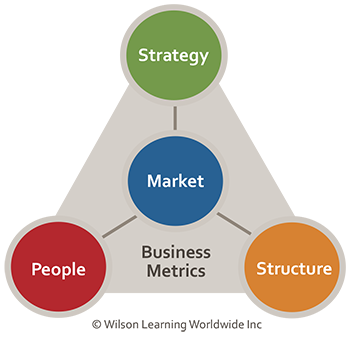Selling to Value
The Art and Science of Discovery

Pat was not happy as she left the meeting with a long-term customer—now a former customer.
“Pat, we have done business together for a long time,” her customer started, “but we have decided to go in a different direction this time.” The customer went on to say how ABC Company, one of Pat’s biggest competitors, worked with them to integrate ABC’s solution into the customer’s systems, resulting in faster inventory turns with fewer shipping errors, and they were able to demonstrate how this will increase margins and profit for the customer.
The ABC Company’s salesperson sold value.
Everything has changed, yet nothing has changed.
Salespeople and sales managers are struggling.
Some have been rendered almost frozen, under the false belief that everything has changed about selling and they don’t know what to do. What had brought them confidence is now a source of anxiety and concern.
Others seem to be operating under the false assumption that nothing has changed. They believe there is no need to change their behavior or learn new skills, but then they struggle upon discovering that many of the old ways of doing things are no longer effective and they don’t understand why.
At stressful times, salespeople, and sales managers, need to reach inside themselves and rediscover the reasons they went into sales—to connect back to the values of the profession and the rewards that come from it, and yes, it is a lot more than just the money.
Selling to Value (S2V) refers to a distinct approach to selling that focuses on aligning your offering to the business value it creates for the customer. This approach requires the sales practitioner to develop an ever-expanding mindset and skill set—and it requires a commitment to a purpose that goes beyond self-interest to include both the interest of the individual customer and the interests of that customer’s business organization.
S2V needs to be considered in all aspects of the sales process: prospecting, qualifying, contacting, proposing, and closing a sales opportunity. But Selling to Value has the greatest impact on how a salesperson discovers needs. Discovering needs is at the very heart of the selling to value relationship. When done correctly, it has a profound effect on the customer’s understanding of their business and where they can generate growth.
Traditional Discovery
In a more traditional sales process, discovery is focused on gathering information about customers’ needs. The salesperson asks good questions; the prospect/customer provides relevant answers. This inquiry proceeds until needs that can be met by the features of the products or services of the selling organization are clearly understood by the salesperson. At that point, the salesperson enters into a discussion of how the features of their products or service meet or exceed the discovered needs of the customer organization. In short, the salesperson explains to the customer how to solve a business problem.
On the surface, there is nothing wrong with this needs-based selling approach; millions of salespeople use it successfully every day. Unfortunately, since almost every salesperson follows this process, your product gets compared to competitors’ products feature by feature. This parity makes it extremely difficult for both the customer and the salesperson to distinguish amongst competing solutions and may confuse the customer into inaction. Therefore, while a traditional discovery process is necessary, it is not sufficient.
Traditional needs discovery ignores additional sources of value that can be brought into consideration. At its core, S2V is a thorough consideration of how the customer organization creates value for its customers. In the S2V approach, the salesperson brings a broader understanding of the customer’s business context into an exploration of the business impact of their decision.

Related Program
Discovery for Selling to Value
In a recent study of buying executives, 94% indicate that they want salespeople to engage them in a business impact discussion—but those same executives indicate that only 19% of salespeople are effective in this regard.
This gap between what buying executives want and what they get is driven by three critical elements:
- The Intention of the Salesperson
- The Science of Creating Value
- The Art of Asking the Next Question
Intention: Where is the Energy Focused?
Where traditional selling may focus its intent on solving the customer’s problem, S2V requires a different intent—advancing the customer’s business. S2V requires salespeople to expand their role beyond finding and solving problems to truly wanting to see their customer’s business flourish and grow.
Salespeople, by their own report, experience different levels of energy associated with their sales activities. When they are focused on solving a problem and achieving their quota, their energy is internally focused and fixed on self-protection. However, when focused on advancing the customer’s business, they report that they feel more focused and fully engaged in the moment. They are free of fear and second-guessing.
Exploring enriching ways to advance the customer’s business performance, in partnership with the customer, creates new energy for creativity and innovation.
The Science of Value Creation
With this clear mindset, moving beyond solving problems and engaging in exploration of how to advance the customer’s business requires salespeople to expand the conversations they have with their customers. These expanded conversations need to follow a discovery process that is focused on the customer as a business. That is, the conversation needs to move beyond the traditional product-centered discussion of problems and solutions. The new business-centered conversation explores how the customer organization produces value for its customers.
We have found that this conversation can be greatly enhanced by following a Business Needs Identification approach.

The Business Needs Identification approach provides an organizing structure to guide the exploration of how the customer organization produces value. The company’s ability to produce value for its customers is influenced by five major elements.
1. Market
Your conversations with customers begin with exploring the market in which the customer organization competes. The value produced by the customer organization is always best understood from the perspective of the market, its customers, and its competitors.
S2V involves exploring market trends and helping the customer organization to exploit opportunities that arise from a growing market or to minimizing the effects of a contracting market.
2. Strategy
The conversation about market forces flows naturally into an exploration of how the customer organization’s strategy addresses their market and produces a competitive advantage. Questions about their source of competitive advantage and their Critical Success Factors (CSFs) dominate S2V discussions to determine their long-term goals and resource allocation.
3. Structure
The customer organization’s strategy cannot be implemented unless the organization’s structure is aligned to execute that strategy. With a solid picture of market conditions and current strategy in place, the conversation easily flows into a discussion of the customer organization’s ability to execute the strategy.
4. People
There is a reason payroll is the single largest business expense: people drive the business forward. Efforts to implement a new strategy require the engagement, not just cooperation, of the people in the organization.
5. Business Metrics
Underlying all the other components are the customer’s business metrics. Knowing what metrics are most important for the customer organization helps you understand how they measure and track their own value production and how they will track the performance of your solution. S2V requires salespeople to become fluent in the way customers talk about and measure their own success.
The Art of Asking the Next Question
We have frequently had this conversation with new salespeople: “I don’t know what happened. I went on a joint call with Sam (company’s top salesperson) and wrote down every question he asked. But when I tried using them, it didn’t work; the client ended the meeting early.”
This is because Sam understood the art of the next question; the new salesperson didn’t.
The S2V discovery process is much more than a list of questions. It is, first of all, a demonstration of the salesperson’s intense and compassionate curiosity about the customer and the ability to let customers lead the discovery process, not the salesperson.
Business professionals love to talk about their work. They are excited to participate in a conversation about the issues that keep them up at night. They can become deeply engaged when they feel they are learning something new or exploring new possibilities for producing more value for their customers.
When a salesperson, in conversation with a customer, offers his or her full experience and expertise in service to the customer’s organization, and allows the discovery process to dig deeply into the concerns of the customer, something special happens. Important information is shared, cooperation and trust strengthen, and new possibilities are created and explored.
Practicing the Art and Science of Discovery
In the past, there was a world in which the customer had limited access to product information, and a simple needs-based approach to selling worked fine for both the salesperson and the customer. Today, the customer has already shopped extensively before agreeing to meet with a salesperson. Customers are looking for something more than an explanation of features; they are looking for a new perspective on how best to move their business forward. They are looking for insight and a new perspective on market trends and competitive positioning.
Sales organizations need to develop an approach to selling that adapts to the way their customers want to make purchasing decisions. Customers have also been pretty clear that they expect salespeople to deliver value.
Customers increasingly expect selling organizations to use and sell to value.
This move from a problem-centered approach to a business-centered approach may seem easy, but it requires three things: a mindset change that places the customer’s business ahead of your own, new knowledge by exploring how the customer’s business runs, and new skills to follow the customer’s lead to the next question.
To learn more, contact Wilson Learning at 1.800.328.7937 or complete the online form.









 Please complete this form to download Selling to Value | The Art and Science of Discovery.
Please complete this form to download Selling to Value | The Art and Science of Discovery.



